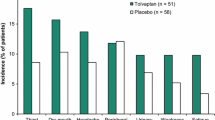Abstract
The key question answered by this study is whether it is possible to deliver a pharmacokinetic and pharmacodynamic duration of antidiuretic action long enough to ensure adequate antidiuresis with two daily administrations of desmopressin in patients with central diabetes insipidus (CDI). We studied the efficacy and safety of desmopressin i.v. in 13 CDI patients using two 3-way crossover designs, in the doses 30, 60, 125 ng, and 125, 250 and 500 ng. Duration of action, minimum output rate, max osmolality and average osmolality during action (AUC osmolality) were measured every 30 min for the first 2 h during the infusion, and then every hour or every second hour until the urine output rate was greater than 2 ml/kg/30 min. The duration of antidiuretic action was 4, 8 and 11 h, respectively, for 125, 250, and 500 ng, increasing from 250 to 500 ng but for the remaining secondary dynamic efficacy parameters no difference could be detected based on descriptive statistics between the doses 250 and 500 ng, indicating that the upper plateau region of the dose–response curve had been reached. All treatment emergent adverse events were classified as unrelated or unlikely related to trial medication. No serious adverse events occurred. Data on duration of action indicates that it is possible to achieve antidiuretic control with 500 ng i.v. corresponding to 160 μg orodispersible tablets twice daily in CDI patients. Today, the Minirin Melt label recommends the majority of CDI patients a dose of 60 to 120 μg t.i.d.




Similar content being viewed by others
References
D.G. Bichet, The posterior pituitary, in The pituitary, 2nd edn., ed. by S. Melmed (Blackwell Publishing, Massachusetts, 2002), pp. 279–314
U. Westgren, C. Wittström, A.S. Harris, Oral desmopressin in central diabetes insipidus. Arch. Dis. Child. 61, 247–250 (1986)
SmPC: DDAVP Melt 60 mcg, 120 mcg and 240 mcg oral lyophilisate 13/11/2009. Electronic Medicines Compendium. http://www.medicines.org.uk/EMC/medicine/17265/SPC/DDAVP+Melt+60mcg%2c+120mcg+and+240mcg++oral+lyophilisate/. Accessed 12 May 2011
H. Vilhardt, Expert Report Oral dDAVP in Diabetes Insipidus and Nocturnal Enuresis (University of Copenhagen, Denmark, 1993)
K.E. Andersson, B. Arner, Effects of DDAVP, a synthetic analogue of vasopressin, in patients with cranial diabetes insipidus. Acta Med. Scand. 192, 21–27 (1972)
C.R.W. Edwards, M.J. Kitau, T. Chard, G.M. Besser, Vasopressin analogue DDAVP in diabetes insipidus: Clinical and laboratory studies. Br. Med. J. 3, 375–378 (1973)
A.G. Robinson, DDAVP in the treatment of central diabetes insipidus. N Eng J Med 294, 507–511 (1976)
I. Fukuda, N. Hizuka, K. Takano, Oral DDAVP is a good alternative therapy for patients with Central diabetes insipidus: Experience of five-year treatment. Endocr. J. 50, 437–443 (2003)
K.S. Lam, M.S. Wat, K.L. Choi, T.P. Ip, R.W. Pang, C.R. Kumana, Pharmacokinetics, pharmacodynamics, long-term efficacy and safety of oral 1-deamino-8-d-arginine vasopressin in adult patients with central diabetes insipidus. Br. J. Clin. Pharmacol. 42, 379–385 (1996)
O. Osterberg, R.M. Savic, M.O. Karlsson, U.S. Simonsson, J.P. Nørgaard, J.V. Walle, H. Agersø, Pharmacokinetics of desmopressin administrated as an oral lyophilisate dosage form in children with primary nocturnal enuresis and healthy adults. J. Clin. Pharmacol. 46, 1204–1211 (2006)
J. Vande Walle, G.A. Bogaert, S. Mattsson, T. Schurmans, P. Hoebeke, V. Deboe, J.P. Norgaard, Desmopressin Oral Lyophilisate PD/PK Study Group: A new fast-melting oral formulation of desmopressin: A pharmacodynamic study in children with primary nocturnal enuresis. BJU Int 97, 603–609 (2006)
K.V. Juul, B.M. Klein, R. Sandström, L. Erichsen, J.P. Nørgaard, Gender difference in antidiuretic response to desmopressin. Am. J. Physiol. Renal Physiol. 5, F1116–F1122 (2011)
R.W. Schrier, in Section XI: Disorders of electrolyte, water, and acid-base. Diseases of the Kidney and Urinary Tract (Lippincott Williams & Wilkins, 2007), p. 2223
J. Vande Walle, M. Stockner, A. Raes, J.P. Nørgaard, Desmopressin 30 years in clinical use: A safety review. Curr. Drug Saf. 2, 232–238 (2007)
Acknowledgements
This work was supported by a grant from Ferring Pharmaceutical.
Author information
Authors and Affiliations
Corresponding author
Rights and permissions
About this article
Cite this article
Juul, K.V., Bichet, D.G. & Nørgaard, J.P. Desmopressin duration of antidiuretic action in patients with central diabetes insipidus. Endocrine 40, 67–74 (2011). https://doi.org/10.1007/s12020-011-9492-z
Received:
Accepted:
Published:
Issue Date:
DOI: https://doi.org/10.1007/s12020-011-9492-z




